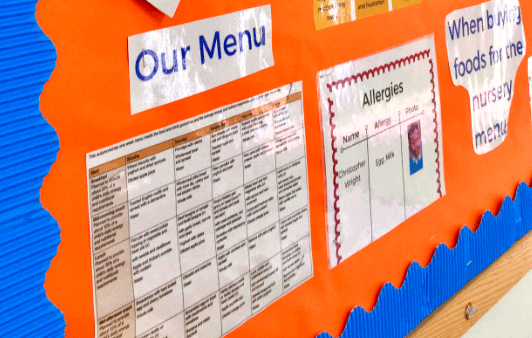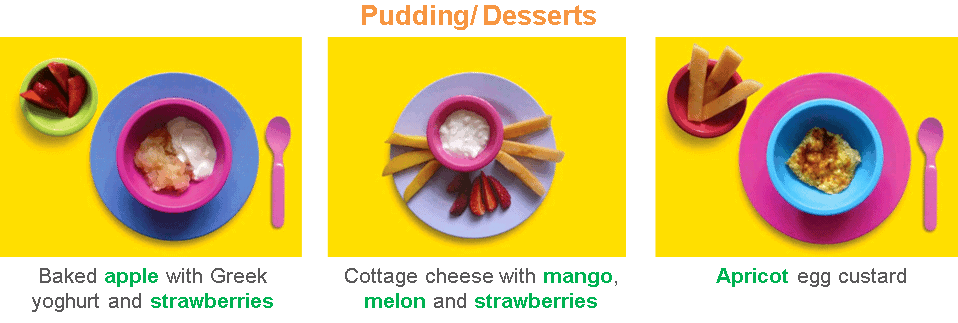In this blog we answer some of the most common questions around menu planning in early years settings. We take a look at some of the common pitfalls we often see when reviewing menus, which will support you to plan nutritious and exciting food for the little ones in your setting!

Are there any guidelines that our early years setting should follow when menu planning?
Yes, the Eat Better Start Better (EBSB) guidelines (opens in new tab) are the voluntary food and drink guidelines for early years settings, here in the UK. Following the EBSB guidelines will support your setting to meet the EYFS welfare requirements for the provision of healthy, balanced and nutritious food and drink.

What does a healthy diet look like for young children?
A healthy balanced diet for children aged one to four years should consist of foods from the 4 main food groups:

This will provide children with energy and a range of essential nutrients that children need to grow and develop.
A key principle of healthy eating is variety! This is because eating a wider range of different foods provides a good balance of nutrients. When menu planning, try to include a variety of food and drinks across meals and snacks, as this will provide children with a good balance of nutrients they need.
How many meals and snacks should we offer and how should we space them out?
Children should be offered:
- 3 mains meals a day- breakfast, lunch and tea
- 2-3 nutritious snacks a day- mid- morning, mid- afternoon and an optional evening snack
Young children have high energy and nutrient requirements, but relatively little tummies, so they need to eat little and often. It’s therefore important to time your meals and snacks so that children eat regularly. When menu planning, ideally you should leave at least a 2 hour gap between each meal and snack, but leave no more than a three hour gap. It’s also important to offer meals and snacks at the same time each day, to help children get into a routine and manage their appetites.

Can we offer rolling snack?
Some nurseries offer a rolling snack bar. This allows children to participate in snack time when they feel ready to and encourages independence. This can work really well and is seen to be less disruptive to children’s playing and learning.
It’s important to remember that a rolling snack bar should be open for a set length of time. Settings who make snacks available to children at any time of the day can create a grazing culture. This means children may have several snacks throughout the day, which is likely to reduce their interest and appetite for the food served at main meals. To avoid this happening, try to carefully organise and manage snack times. Limit the time your snack bar’s open to around 30-60 minutes, and remember to factor this in when timing your main meals.
For more tips and advice on how to ensure the smooth running of rolling snack, check out our snacks blog here (opens in new tab).

What are some of the common menu planning pitfalls?
Having reviewed many nursery menus, we often see the following issues:
Not including beans, pulses, fish, eggs, meat or other protein food at lunches and teas
What do the EBSB guidelines say?
- Provide a portion of beans, pulses, fish, eggs, meat, or other proteins as part of lunch and tea
- Offer protein foods as part of snacks once or twice each week
- Include a variety of protein foods every day and across the week.

Protein foods for vegetarian children are sometimes missing from lunch and tea
What do the EBSB guidelines say?
- Provide vegetarian children with two or three portions of pulses, eggs, meat alternatives or nuts* each day
- Include a variety of protein sources such as pulses, eggs and meat alternatives each week as part of lunch and tea
- Offer one lunch and one tea for all children each week which uses pulses or a meat alternative as the protein source
- For more information on catering for children who are vegetarian in your setting, check out our blog here (opens in new tab).
*Whole nuts and peanuts shouldn’t be given to children under 5 years old, as they can choke on them.

Fruit is offered frequently at snack time, but vegetables are not offered as frequently
What do the EBSB guidelines say?
- Provide a portion of vegetable and/or fruit at each meal and with some snacks
- Include a variety of vegetables and fruits, aiming to offer at least four different types during full day care, and two different types during sessional care.

The same fruits and vegetables are offered across spring/ summer and autumn/ winter menus
What do the EBSB guidelines say?
- Provide a variety of vegetables and fruits
- Choose food that is grown locally and that is in season where possible
- Use a British seasonal food chart (opens in new tab) to help you to identify foods in season
- Your setting could even try growing your own! This will help to teach children about where food comes from, about life cycles, about gardening and how to look after plants!

Dried fruit offered at snack times
What do the EBSB guidelines say?
- Provide dried fruit at meal times only rather than as a snack, e.g. with breakfast or as part of puddings
- Dried fruit contains sugars that can stick to and may damage children’s teeth.
Puddings and desserts not offered alongside lunch and tea
What do the EBSB guidelines say?
Desserts, puddings and cakes made with cereals (such as rice or oats), milk and fruit can be included as part of a healthy diet. Desserts and cakes provide energy (calories) and essential nutrients such as calcium and iron.
- A dessert should be provided as part of lunch and tea each day
- Vary the desserts you offer with lunch and tea each week
- For main meals (typically lunch), provide a variety of different desserts each week (e.g. fruit-based such as apple crumble, dairy-based desserts such as rice pudding) and limit provision of cakes and biscuits
- For light meals (typically tea) provide fruit (such as seasonal fruit salad) and/or dairy-based desserts such as yoghurt, and avoid cakes and biscuits
- Avoid all sweet foods at snacks time as these can damage children’s teeth
- Limit confectionery such as chocolate chips and hundreds and thousands and use only as part of cakes or desserts.

There can be limited food from other cultures
What do the EBSB guidelines say?
- Many early years settings in England have a diverse population, with children attending from different ethnic and religious groups
- Make sure you cater for the cultural and dietary needs of all the children in your care
- Even if there are no children from minority ethnic or religious groups attending, it’s still important to introduce all children to a variety of foods. This is so they can learn to appreciate the diets of different cultures.
Early Start Nutrition Example Menus:
- Spring/ Summer Menus (Word, 114KB)
- Autumn/ Winter Menus (Word, 105KB)
- Vegetarian Menu (Spring/ Summer) (Word, 110KB)

Looking to review your Nursery menu?
Our expert Registered Nutritionists provide comprehensive reviews to ensure nursery menus meet the Eat Better Start Better voluntary food and drink guidelines.

Training
For more information and tips on planning your menus, check out our online Menu Planning training (opens in new tab), created especially for early years settings-only £36!
- How to produce healthy balanced menus that meet the Eat Better, Start Better food and drink based guidelines.
- How to develop menus that cater for all special dietary requirements (including vegetarian diets, allergies, cultural and religious requirements).
- Ways to support children at mealtimes, considering the dining environment, strategies to manage fussy eating and cooking activities.

